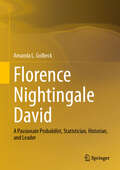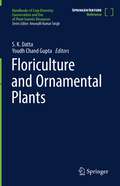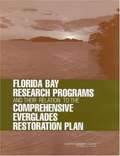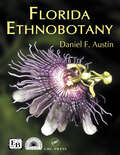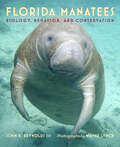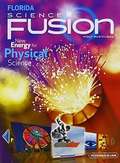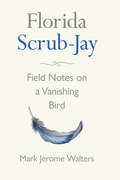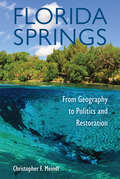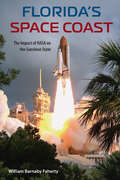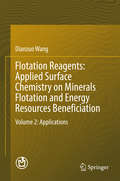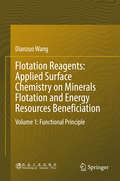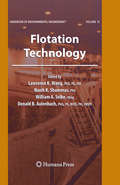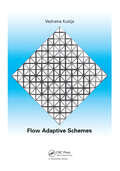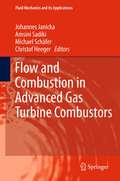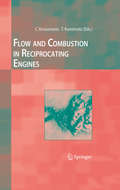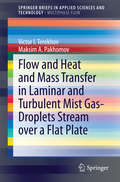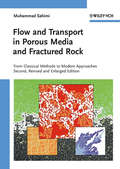- Table View
- List View
Florence Nightingale David: A Passionate Probabilist, Statistician, Historian, and Leader
by Amanda L. GolbeckThis book examines Florence Nightingale David's life, contributions, and relationships throughout her life, as well as her subsequent legacy. Florence Nightingale David (1909-1993) was the first woman professor in the world's first academic statistics department, served in various British ministries during the war from 1939-1945, and was one of the first women to chair a statistics department in a research university. In this biography, the life stories of David are used as a vehicle to explore a variety of questions surrounding culture and engagement in the statistical sciences. What does it take to succeed in an environment that is not inclusive of your demographic? How can stories be used to bring technical material to life for students and other learners? And how can a nontraditional leader succeed in challenging boundaries and moving an enterprise forward?
Floriculture and Ornamental Plants (Handbooks of Crop Diversity: Conservation and Use of Plant Genetic Resources)
by S. K. Datta Youdh Chand GuptaThe volume on oilseed crops is developed as a part of a series on “Handbook of Agrobiodiversity: Conservation and Use of Plant Genetic Resources”. The handbook would function as a ready reference book for availability of PGR globally, along with specific source, wherefrom they can be procured, and used breeding programs, particularly to overcome various crop production constraints and to improve productivity and quality. The volume on floriculture and ornamental plants will be the source of basic information on origin and evolution and global dispersal of cultivated species of ornamentals. Presently, floriculture has established its credibility in improving income through increased productivity, generating employment and in enhancing exports. All research and developmental activities on ornamental crops are essentially multi-disciplinary in nature recognizing local issues as well as country issue. Floriculture is developing as an area of high technology based frontier interdisciplinary area on scientific excellence. Floriculture has progressed both scientifically and commercially due to concentrated efforts made on multidisciplinary research. It is developing as an area of high technology based frontier interdisciplinary area on scientific excellence. The volume will contain all information about different ornamentals. This shall be put together to develop a complete documentation of the results of the research and demonstrations conducted by different scientists. The volume will provide an illustrated horto-taxonomical account of important ornamental species and cultivars, germplasm status and their usages, propagation, nursery management, techno-economics, conventional breeding, induced mutagenesis, new varieties, cytogenetics, tissue culture, characterization of varieties, dehydration of flowers etc. This volume will give a coherent and concise account on recent developments. It will deal with all the important and relevant aspects of floriculture. The publication of this volume is planned to reveal multifarious activities done on different aspects of floriculture so that innovations made so far can be used judiciously for this sector. This book shall provide authoritative review account of many aspects of current interest and progress in the field of floriculture. The topics included in the book are interdisciplinary and cater not only classical floriculture but also relevant modern aspects. The book will provide valuable data on different aspects and will be widely accepted by by professional scientists, researchers, teachers, students, floriculturists, technocrats and planners. The volume will be an invaluable asset to floriculture scientists.
Florida Bay Research Programs And Their Relation To The Comprehensive Everglades Restoration Plan
by Committee on Restoration of the Greater Everglades EcosystemThe National Academies Press (NAP)--publisher for the National Academies--publishes more than 200 books a year offering the most authoritative views, definitive information, and groundbreaking recommendations on a wide range of topics in science, engineering, and health. Our books are unique in that they are authored by the nation's leading experts in every scientific field.
Florida Chemistry
by Antony C. Wilbraham Dennis D. Staley Michael S. Matta Edward L. WatermanNIMAC-sourced textbook
Florida Ethnobotany
by Daniel F. Austin� Winner of the 2005 Klinger Book AwardPresented by The Society for Economic Botany. Florida Ethnobotany provides a cross-cultural examination of how the state�s native plants have been used by its various peoples. This compilation includes common names of plants in their historical sequence, weaving together what was formerly esoteri
Florida Holt Science & Technology, Level Green
by Mario Affatigato Katy Z. Allen Linda Ruth BergNIMAC-sourced textbook
Florida Interactive Science: Physical Science
by Don Buckley Zipporah Miller Michael J. Padilla Kathryn Thornton Michael E. WysessionNIMAC-sourced textbook
Florida Interactive Science: Life Science
by Don Buckley Zipporah Miller Michael J. Padilla Kathryn Thornton Michael E. WysessionNIMAC-sourced textbook
Florida Manatees: Biology, Behavior, and Conservation
by John E. Reynolds IIIA photographic journey into the secret world of Florida’s beloved manatee.Winner of the CHOICE Outstanding Academic Title of the Choice ACRLManatees, the gentle giants of Florida's lagoons and coastal habitats, can bring a smile to the face of anybody lucky enough to spy one. As manatees dip and roll through the water, crowds gather to watch them feed on aquatic vegetation. Whether they are congregating by the hundreds or resting or feeding alone, viewing these sea cows can provide anyone interested in nature with hours of tranquil pleasure.Having survived for eons, today's manatees are now under constant threat due to our rapidly swelling human population. Their habitats are often devastated by development and pollution. The slow-moving manatees also live at the mercy of chance, for they occupy waters filled with fast-moving boats powered by razor-sharp propellers—a new form of predator from which they have no protection. Boat speed limits have been put in place to protect manatees, but there is a constant push to lift them so that people can once again zip across the waters that manatees call home. For this reason, manatees are often a subject of controversy that pits their lives against the rights of boat owners. In this book, manatee expert John E. Reynolds III and famed photographer Wayne Lynch join forces to reveal the clearest portrait of manatees ever published. Florida Manatees is a song for the manatee, a celebration of the lives of these majestic creatures. Reynolds's concise, informative text shares what scientists know about manatees, while Lynch's beautiful photographs instantly demonstrate how special these "potatoes with whiskers" really are. By encouraging an appreciation of manatees, the authors hope to help ensure a future in which Floridians can find ways to coexist with and continue to enjoy these uniquely wonderful sirenian inhabitants of their state.Included in this book: How manatees first came to Florida waters How manatees fit into the ecosystems of Florida What and how much manatees eat How manatees behave and communicate with one another Why manatees look the way they do Why manatees have whiskers How manatee mothers feed their young and much more
Florida Manatees: Biology, Behavior, and Conservation
by John E. Reynolds IIIA photographic guide that “focuses on the beauty, grace and vulnerability of these herbivores, but it also covers other sea mammals and their habitats” (The Biologist).Named a Choice Outstanding Academic TitleIn this book, manatee expert John E. Reynolds III and famed photographer Wayne Lynch join forces to reveal the clearest portrait of manatees ever published. Florida Manatees is a song for the manatee, a celebration of the lives of these majestic creatures. Reynolds’s concise, informative text shares what scientists know about manatees, while Lynch’s beautiful photographs instantly demonstrate how special these “potatoes with whiskers” really are. By encouraging an appreciation of manatees, the authors hope to help ensure a future in which Floridians can find ways to coexist with and continue to enjoy these uniquely wonderful sirenian inhabitants of their state.Included in this book:How manatees first came to Florida watersHow manatees fit into the ecosystems of FloridaWhat and how much manatees eatHow manatees behave and communicate with one anotherWhy manatees look the way they doWhy manatees have whiskersHow manatee mothers feed their young and much more“A lovely book that sounds as though it would appeal primarily to scientists, but which offers inviting color photos and history that make it accessible to lay audiences both within Florida and outside the state.” —Donovan’s Literary Services
Florida Physical Science
by Charles William McLaughlin Marilyn Thompson Dinah ZikeNIMAC-sourced textbook
Florida Science Fusion: New Energy for Physical Science
by Michael A. DiSpezio Marjorie Frank Michael R. HeithausNIMAC-sourced textbook
Florida Scrub-Jay: Field Notes on a Vanishing Bird
by Mark Jerome WaltersA portrait of a species on the brink The only bird species that lives exclusively in Florida, the Florida scrub-jay was once common across the peninsula. But as development over the last 100 years reduced the habitat on which the bird depends from 39 counties to three, the species became endangered. With a writer’s eye and an explorer’s spirit, Mark Walters travels the state to report on the natural history and current predicament of Florida’s flagship bird.Tracing the millions of years of evolution and migration that led to the development of songbirds and this unique species of jay, Walters describes the Florida bird’s long, graceful tail, its hues that blend from one to the next, and its notoriously friendly manner. He then focuses on the massive land-reclamation and canal-building projects of the twentieth century that ate away at the ancient oak scrub heartlands where the bird was abundant, reducing its population by 90 percent.Walters also investigates conservation efforts taking place today. On a series of field excursions, he introduces the people who are leading the charge to save the bird from extinction—those who gather for annual counts of the species in fragmented and overlooked areas of scrub; those who relocate populations of scrub-jays out of harm’s way; those who survey and purchase land to create wildlife refuges; and those who advocate for the prescribed fires that keep scrub ecosystems inhabitable for the species.A loving portrayal of a very special bird, Florida Scrub-Jay is also a thoughtful reflection on the ethical and emotional weight of protecting a species in an age of catastrophe. Now is the time to act, says Walters, or we will lose the scrub-jay forever.
Florida Springs: From Geography to Politics and Restoration
by Christopher F. MeindlAn indispensable resource for learning about the freshwater wonders of Florida Florida is home to over 1,000 freshwater springs, natural wonders that have drawn people to enjoy and interact with them over the course of millennia. This book provides a clear and comprehensive overview of the geography, history, science, and politics of the springs, informing readers about the deep past and current issues facing these treasures of the Florida landscape. Christopher Meindl explains the unique physical features of Florida’s springs, including the “swiss cheese” structure of the state’s aquifers and the complexities of its groundwater hydrology, providing helpful maps, graphs, and photos. Meindl discusses how ancient and modern people have used the springs—as centers of communities, therapeutic spas, roadside attractions, parks, and more. He addresses contemporary threats to the springs in areas such as water flow, water quality, and overcrowding. Finally, he explores recent state policies, the activism of environmentalists, and current and potential restoration projects that seek to prevent springs degradation. Meindl brings to light a struggle for truth among scientists, politicians, and businesspeople about the causes of problems the springs face today. Challenging oversimplified answers and looking at multiple hypotheses, Meindl raises intriguing questions that will inspire readers to join the ongoing discussion about how best to protect and restore Florida’s iconic freshwater sanctuaries.
Florida's Space Coast: The Impact of NASA on the Sunshine State (Florida History and Culture)
by William B. Faherty"An important, interesting study of the relations between the Kennedy Space Center and the communities of Brevard County, Florida."--Roger D. Launius, chief historian, NASA, Washington, D.C."This outstanding book provides readers of Florida history our first insight into the impact that high technology has had on the state. Brevard County is a veritable laboratory for understanding what happens when space science and engineering put down roots in a wilderness setting. Faherty's writing is direct, simple, even folksy at times. I devoured it!"--Michael Gannon, author of Pearl Harbor Betrayed and A Short History of FloridaFlorida&’s Space Coast tells the compelling story of America's half century in space exploration, from the successful launch of the first two-stage rocket in 1950 through the latest space shuttle missions of 2000. Told from the unique viewpoint of the people who built the Spaceport, this book shows how the space program transformed the east central Florida coast from a traditional citrus production and tourist area to one of the most influential high-tech centers in the nation.Cape Canaveral was chosen as a missile launch site because of its many geographical advantages. However, in the early years of the space program, the area was far from an ideal place for NASA employees to raise their families. NASA brought in thousands of space-related workers, who, besides sending machines and men into space, had to meet the challenge of moving their families from urban environs to a rural southern county. This book engagingly recounts the parallel stories of the establishment of America's space program and its impact on the development of Brevard County.William Barnaby Faherty is professor emeritus of history at St. Louis University and director of the Museum of the Western Jesuit Missions in Hazelwood, Missouri.
Flotation Reagents: Applied Surface Chemistry on Minerals Flotation and Energy Resources Beneficiation
by Dianzuo WangThis volume presents essential information on chemical reagents commonly used in flotation processes. It comprehensively summarizes the properties, preparation and applications of collectors, frothers, depressants and flocculants. It also discusses the microanalysis of flotation reagents and adsorption measurement. The book offers a valuable resource for all university researchers and students, as wells as R&D engineers in minerals processing and extractive metallurgy who wish to explore innovative reagents and technologies that lead to more energy efficient and environmentally sustainable solutions.
Flotation Reagents: Applied Surface Chemistry on Minerals Flotation and Energy Resources Beneficiation
by Dianzuo WangThis book summarizes the author's findings on the functional principle of flotation reagents, gathered over the past few decades. The fundamentals of and approaches common to surface chemistry are applied to study the reagents' structure and performance, as well as their interaction with minerals. In particular, the book establishes the theoretical criteria for collector performance. It also includes the quantum chemistry parameters, steric configuration, HOMO and LUMO surface of various reagents. The book offers a valuable resource for all university graduate students, researchers and R&D engineers in minerals processing and extractive metallurgy who wish to explore innovative reagents and technologies that lead to more energy efficient and environmentally sustainable solutions.
Flotation Technology
by Lawrence K. Wang Nazih K. Shammas Donald B. Aulenbach William A. SelkeThe Handbook of Environmental Engineering series is an incredible collection of methodologies that study the effects of pollution and waste in their three basic forms: gas, solid, and liquid. This exciting new addition to the series, Volume 12: Flotation Technology, has been designed to serve as both a basic flotation textbook and a comprehensive reference book. An indispensable guide for advanced undergraduate and graduate students, designers of water and wastewater treatment systems, scientists, and researchers, this volume is essential for all readers who are interested in the specialized investigation of the theory and practice of various wastewater systems. A critical volume in the Handbook of Environmental Engineering series, chapters employ methods of practical design and calculation illustrated by numerical examples, include pertinent cost data whenever possible, and explore in great detail the fundamental principles of the field. Volume 12: Flotation Technology, provides information on some of the most innovative and ground-breaking advances in the field today from a panel of esteemed experts. Coverage of the principles of air flotation technology and the fundamentals of water and wastewater flotation and lake restoration. Emphasis on industry standards, trends in the field, full-scale operation and laboratory simulation of air flotation processes. Examples of actual operating water and wastewater treatment plants based on air flotation Reference of practical use to scientists, researchers, educators and designers of water and wastewater treatment systems. Contents: Principles of Air Flotation Technology. Gas Dissolution, Release, and Bubble Formation. Separation of Oil From Wastewater. Fundamentals of Wastewater Flotation. Electroflotation. Electrocoagulation-flotation. Treatment of Paper Mill Whitewater. Recycling and Recovery of Raw Materials. Ozone-oxygen Oxidation Flotation, Wastewater Renovation by Flotation. Flotation-Filtration System for Wastewater Reuse. Algae Removal by Flotation. Completely Closed Water Systems in Paper Mills. Lake Restoration Using DAF. Jiminy Peak, Hancock, Massachusetts Wastewater Treatment Plant. Pittsfield, Massachusetts Water Treatment System. Pretreatment of Meat Processing Waste. Treatment of Seafood Processing Wastewater. Laboratory Simulation of Air Flotation Processes. Appendix. Index.
Flow Adaptive Schemes
by Vendrana KutijaA study in the development of flow adaptive numerical schemes in computational hydraulics directed to enhancing modelling capabilities. Examples covered include additional flow resistance due to flexible vegetation; one-dimensional supercritical flow; and flow in networks of channels.
Flow and Combustion in Advanced Gas Turbine Combustors
by Amsini Sadiki Christof Heeger Johannes Janicka Michael SchäferWith regard to both the environmental sustainability and operating efficiency demands, modern combustion research has to face two main objectives, the optimization of combustion efficiency and the reduction of pollutants. This book reports on the combustion research activities carried out within the Collaborative Research Center (SFB) 568 "Flow and Combustion in Future Gas Turbine Combustion Chambers" funded by the German Research Foundation (DFG). This aimed at designing a completely integrated modeling and numerical simulation of the occurring very complex, coupled and interacting physico-chemical processes, such as turbulent heat and mass transport, single or multi-phase flows phenomena, chemical reactions/combustion and radiation, able to support the development of advanced gas turbine chamber concepts
Flow and Combustion in Reciprocating Engines
by Take Kamimoto C. ArcoumanisOptimization of combustion processes in automotive engines is a key factor in reducing fuel consumption. This book, written by eminent university and industry researchers, investigates and describes flow and combustion processes in diesel and gasoline engines.
Flow and Heat and Mass Transfer in Laminar and Turbulent Mist Gas-Droplets Stream over a Flat Plate
by Victor I. Terekhov Maksim A. PakhomovIn this book the author presents selected challenges of thermal-hydraulics modeling of two-phase flows in minichannels with change of phase. These encompass the common modeling of flow boiling and flow condensation using the same expression. Approaches to model these two respective cases show, however, that experimental data show different results to those obtained by methods of calculation of heat transfer coefficient for respective cases. Partially that can be devoted to the fact that there are non-adiabatic effects present in both types of phase change phenomena which modify the pressure drop due to friction, responsible for appropriate modelling. The modification of interface shear stresses between flow boiling and flow condensation in case of annular flow structure may be considered through incorporation of the so called blowing parameter, which differentiates between these two modes of heat transfer. On the other hand, in case of bubbly flows, the generation of bubbles also modifies the friction pressure drop by the influence of heat flux. Presented are also the results of a peculiar M-shape distribution of heat transfer coefficient specific to flow boiling in minichannels. Finally, some attention is devoted to mathematical modeling of dryout phenomena. A five equation model enabling determination of the dryout location is presented, where the mass balance equations for liquid film, droplets and gas are supplemented by momentum equations for liquid film and two-phase core.
Flow and Transport in Porous Media and Fractured Rock: From Classical Methods to Modern Approaches
by Muhammad SahimiIn this standard reference of the field, theoretical and experimental approaches to flow, hydrodynamic dispersion, and miscible displacements in porous media and fractured rock are considered. Two different approaches are discussed and contrasted with each other. The first approach is based on the classical equations of flow and transport, called 'continuum models'. The second approach is based on modern methods of statistical physics of disordered media; that is, on 'discrete models', which have become increasingly popular over the past 15 years. The book is unique in its scope, since (1) there is currently no book that compares the two approaches, and covers all important aspects of porous media problems; and (2) includes discussion of fractured rocks, which so far has been treated as a separate subject. Portions of the book would be suitable for an advanced undergraduate course. The book will be ideal for graduate courses on the subject, and can be used by chemical, petroleum, civil, environmental engineers, and geologists, as well as physicists, applied physicist and allied scientists that deal with various porous media problems.
